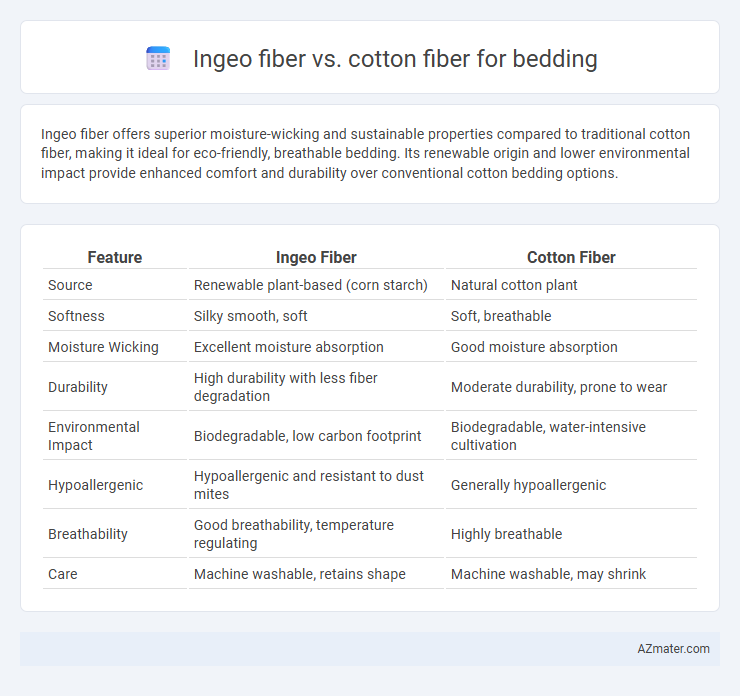Ingeo fiber offers superior moisture-wicking and sustainable properties compared to traditional cotton fiber, making it ideal for eco-friendly, breathable bedding. Its renewable origin and lower environmental impact provide enhanced comfort and durability over conventional cotton bedding options.
Table of Comparison
| Feature | Ingeo Fiber | Cotton Fiber |
|---|---|---|
| Source | Renewable plant-based (corn starch) | Natural cotton plant |
| Softness | Silky smooth, soft | Soft, breathable |
| Moisture Wicking | Excellent moisture absorption | Good moisture absorption |
| Durability | High durability with less fiber degradation | Moderate durability, prone to wear |
| Environmental Impact | Biodegradable, low carbon footprint | Biodegradable, water-intensive cultivation |
| Hypoallergenic | Hypoallergenic and resistant to dust mites | Generally hypoallergenic |
| Breathability | Good breathability, temperature regulating | Highly breathable |
| Care | Machine washable, retains shape | Machine washable, may shrink |
Introduction to Ingeo Fiber and Cotton Fiber
Ingeo fiber, derived from renewable plant-based materials such as corn, offers a sustainable alternative to traditional cotton fiber in bedding applications. Cotton fiber, a natural textile harvested from the cotton plant, has been widely used for its softness and breathability. Ingeo fiber provides enhanced moisture-wicking properties and biodegradability, making it an eco-friendly choice compared to conventional cotton bedding fabrics.
Composition and Source of Ingeo vs. Cotton
Ingeo fiber is a biopolymer made from renewable plant sugars, primarily derived from corn, offering a sustainable alternative to traditional fibers. Cotton fiber comes from the natural seed hairs of the cotton plant, characterized by its cellulose-based composition. Ingeo's eco-friendly production reduces reliance on petroleum, while cotton, though natural, requires extensive water and pesticide use.
Environmental Impact and Sustainability
Ingeo fiber, derived from renewable plant-based materials like corn, boasts a significantly lower carbon footprint compared to traditional cotton, which requires extensive water, pesticides, and land resources for cultivation. Ingeo's biodegradability and closed-loop manufacturing process enhance its sustainability credentials by minimizing waste and toxic runoff. Conversely, cotton production remains resource-intensive and contributes to soil degradation and water scarcity, despite organic cotton options offering some environmental benefits.
Breathability and Moisture Management
Ingeo fiber, derived from renewable plant starch, offers superior breathability compared to traditional cotton fiber, enabling enhanced airflow and temperature regulation in bedding. Its moisture-wicking properties efficiently draw sweat away from the body, maintaining a dry and comfortable sleep environment. Cotton fiber, while naturally breathable, tends to retain moisture longer, which can lead to discomfort and reduced freshness over time.
Comfort and Softness Comparison
Ingeo fiber, derived from renewable plant sources, offers a smooth, silky texture that enhances bedding comfort through excellent moisture-wicking and breathability, maintaining a cool sleep environment. Cotton fiber, known for its natural softness and durability, provides a plush feel that becomes softer with each wash, ensuring long-term comfort. Both fibers excel in softness, but Ingeo's sustainability and temperature regulation give it an edge in modern, eco-friendly bedding solutions.
Durability and Longevity in Bedding
Ingeo fiber, made from renewable plant-based materials, offers superior durability and resistance to wear compared to traditional cotton fiber in bedding applications. Unlike cotton, which tends to weaken and lose strength over repeated washes, Ingeo maintains its structural integrity longer, ensuring extended bedding longevity. Its natural moisture-wicking and thermal regulation properties contribute to sustained comfort and durability in everyday use.
Allergenicity and Hypoallergenic Properties
Ingeo fiber, derived from renewable plant-based sources like corn, exhibits natural hypoallergenic properties with resistance to dust mites and mold, making it an excellent choice for allergy-sensitive bedding. Cotton fiber, while breathable and soft, tends to retain moisture more, which can promote dust mite proliferation and increase allergen exposure. The inherent moisture-wicking and antimicrobial qualities of Ingeo fiber reduce allergen build-up, providing a healthier sleeping environment compared to traditional cotton bedding.
Maintenance and Care Requirements
Ingeo fiber bedding offers low maintenance due to its natural resistance to wrinkles and shrinkage, requiring gentle machine wash with mild detergents and air drying to maintain fabric integrity. Cotton fiber bedding demands more frequent washing and careful handling to prevent fading and fiber wear, often benefiting from cold water washes and avoiding high heat drying. Both materials require timely removal from the dryer to reduce wrinkles, but Ingeo's moisture-wicking properties enhance durability and ease of care over traditional cotton.
Cost Comparison and Market Availability
Ingeo fiber, derived from renewable plant starch, often costs more upfront than traditional cotton fiber due to its advanced manufacturing process and sustainable sourcing. Cotton fiber remains widely available globally at competitive prices, benefiting from established supply chains and extensive agricultural production. Market availability for Ingeo bedding is expanding but still limited compared to the abundant and diverse offerings of cotton-based bedding products.
Final Verdict: Which Fiber is Better for Bedding?
Ingeo fiber offers superior moisture-wicking and temperature regulation compared to cotton fiber, making it ideal for hot sleepers or humid climates. Cotton fiber provides a natural softness and breathability that enhances comfort and durability, favored for all-season bedding. Choosing between Ingeo and cotton fibers depends on your priority: advanced eco-friendly performance with Ingeo or classic comfort and reliability with cotton.

Infographic: Ingeo fiber vs Cotton fiber for Bedding
 azmater.com
azmater.com